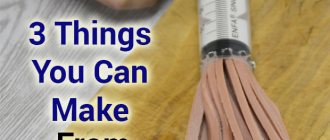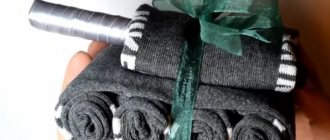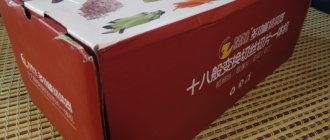For a small kitchen, installing full-fledged household appliances sometimes becomes a problem. The same can be said about dacha conditions. This is where a tabletop electric stove with oven comes to the rescue.
This device is as compact as possible, but can replace a stationary stove. It is easy to install it anywhere, even in a room. Manufacturers offer a large number of options for such ovens; it is only important to figure out how to choose the best one.
DIY electric stove
Homemade base for everyone!
- Homemade products for the garden
- Adaptations
- Homemade cars
- Electronic homemade products
- Homemade crafts
- alternative energy
- DIY furniture
- Construction and repair
- For fishing and hunting
- Crafts and handicrafts
- Homemade material
- Homemade products for PC
- Super homemade products
- Other homemade products
5 new crafts!
After the house was built, a rather spacious attic emerged; the idea of arranging it had been around for a long time! “An attic studio for guests, creativity, games and relaxation” is already ready. But the staircase is not all the way to the end. How to make an unusual greenhouse-breadbox with your own hands An excellent homemade device for storing tools for a home workshop. Step-by-step process for making a cool dog house with a lookout area. Beautiful key holder in the shape of a Dachshund dog for DIY production. Templates for cutting from plywood. How to make an electric stove from refractory bricks How to make an electric stove from refractory bricks
In this article I will tell you how to make a homemade electric stove from brick for just $1 and without having any special expensive materials.
And for this we will use: a refractory brick, a spiral from an electric stove, a couple of bolts with screws, two pieces of glass fabric to seal our screws and, of course, we need a fork with a cable.
Next we make the following cuts in our brick, they are needed to insert a nichrome spiral
Next, we make a couple of holes in the brick with a stone drill; we need these recesses to screw our bolts into them and connect the power source to our spiral.
Next, we insert glass fabric into our recesses to better seal the screws and screw in the screws themselves.
Next we screw the nuts onto the screws and put on the washers and now all we have to do is put on the spiral
How to make an electric stove/heater from improvised materials
Hello to all DIYers! Today in this article we will look at how to make a very useful “garage” homemade product. Why a garage? Well, firstly, you are unlikely to need such a thing at home, and we will be assembling it from improvised means, and no attention will be paid to appearance. Namely, today we will look at how to make an electric stove on which you can cook, heat or warm up anything. Surely you at least once needed a similar thing in the garage, but you were sorry for the money, since the “tool” is not entirely important. So, the budget for this homemade product is extremely small, since most of the elements necessary for assembly probably already exist in the garage. Well, well, I think there’s no need to delay with a long preface, let’s go.
For a homemade electric stove you will need: - Two tin cans of different sizes - Clay (for example, pottery clay) - Computer cooling fan - A spool of nichrome thread (for example: 20 M, 0.50mm, 7.14 Ohm/M) - Power cord with plug / Step-down converter from 220V AC to 12-24V DC.
You will also need the following tools: - Hammer. - Can opener - Plastic bag - Drill with cutting disc - Regular thread - Something cylindrical, such as glue sticks. — Pliers / wire cutters — Soldering iron — Heat shrink — Ordinary wire — Marker — Wooden stick.
Let's start assembling the electric stove (heater).
The first step is to make the most basic part of the homemade product, namely the base on which we will continue the assembly. For it you will need to take some kind of tin can, the volume of which will be at least one liter (the larger the can, the larger and more powerful the stove / heater).
In the tin can you took, you should remove the top and bottom parts so that we get a blank that resembles a pipe. To do this, use a bottle opener or a simple knife to cut out these elements. Next, you should remove the tin burrs remaining after the work done, which will only interfere during assembly. We tap them on the inside of the can with a hammer until all the burrs are removed.
After which the structure should be made more heat-intensive. And for this, the walls of the jar should be lined with clay. In order to perform this apperception, we repeat the following steps. We put a plastic bag on the table, a jar on it (the bag is needed so that the clay does not stick to the table) and evenly fill the bottom of the jar with clay. You can use absolutely any clay; the author of the homemade product used “pottery” clay, which is usually sold in vacuum packaging, already diluted, and you don’t have to knead anything.
After we have evenly distributed the clay over the bottom of the jar, take another plastic bag and a tin jar smaller than the previous one. We wrap the jar in a plastic bag, secure it to the jar with tape so that the bag is stretched over the jar, and place it exactly in the center of the large jar. The space between the walls of the two jars should be tightly and completely filled with clay. As a handy tool for this work, we will take some kind of stick with which we will hammer the clay.
After following the steps described earlier, carefully remove the inner tin from the large jar. First we take out the jar itself, and only then the plastic bag. As you can see, due to the fact that we used a plastic bag, we were able to easily remove the jar, otherwise it simply would not have been possible to do this!
The next step is to make a part of the structure in which the fan will be installed for blowing. To do this, take a jar of a suitable diameter to install your fan in it; the jar used earlier was perfect for the author. We apply a small jar to the side of the structure and outline it with a marker, and then, taking a drill with a metal cutting disc, cut a hole along the contour.
Having cut a side hole in a large jar, we observe clay, which should be carefully removed from there. In order to carefully cut out a round disk of clay, you should use a needle and thread. We insert a needle and thread through the clay and, using the thread itself, carefully cut out a round hole (see photo).
Into the already completed hole we insert the tin can for which this hole was made. Due to the fact that our stacks are clay and thick, the tin can does not require any additional fixation in the design; it will stick there well.
After that, you should make a burner in which a nichrome thread will be installed, on which the heated object will in turn be placed. To do this, we sculpt a “lid” for a jar from the same clay, that is, the outer diameter of the disk should not exceed the inner diameter of a large tin can. In the molded lid, mark a circle exactly in the center with a diameter equal to the diameter of a small jar.
Inside the drawn circle on the lid, round holes should be made for air supply. Thermal gun rods are perfect for making such holes. We insert the sections from the rods into the lid so that we have several rows of holes in the lid (see photo). We insert the lid into place and finally adjust it in size so that there is no gap between the jar and the lid. Then remove the glue sticks from the lid. We check the holes for clearance; they must be through. As a result, we should have a design similar to the one shown below. Let's move on to clay modeling again. Between the holes we should mold and lay “sausages” so that we get a groove in which the nichrome thread will be located. In short, we repeat the steps from the data images below. We stick larger clay “sausages” to the edges of the lid (the dishes will be placed on them). We install a fan on a tin can placed on the side of a large can. To do this, using a drill, we drill several through holes around the perimeter of the edge of the can. And install the fan, securing it with wire, as indicated below. Instead of wire, you can use plastic ties.
Let's move on to the most important part of the homemade product. To the heating part. First of all, you need to decide which network you will be powered from. It’s just that if you power the nichrome filament from 220V, you will have to separately power the fan from 12-24V. In order to calculate the final power of the heater, you can calculate the required length and thickness of nichrome using special calculators, which are a dime a dozen on the Internet.
Having decided on the quantity and thickness of the thread, we wind it around a screwdriver, creating a spiral. We lay the spiral itself through the gutter prepared earlier.
We connect the wires and insulate the connection point with heat shrink. We also add a little clay to the places where the wire connects with the thread (see photo). In this case, the clay is responsible for attaching the wires to the “body” so that we do not accidentally tear them off in the future. We connect the fan. The fan can be connected in parallel if you use a voltage of 12-24V.
Here is a video from the author of the homemade product:
Wiring Requirements
Important! Before you begin any manipulations with wires and electrical appliances, turn off the electricity supply to your house or apartment.
Modern models of electric stoves are usually sold without a cord included. There is a reasonable explanation for this: safety regulations require that such devices be connected using high-quality terminal blocks, i.e. according to the so-called rosette-free method. With this connection option, you can increase the length of the power cord, and instead of a machine for more powerful models, you can install a fuse-link.
For connection, you need to use a cable with a cross-section of 4 mm 2 if its length does not exceed 12 m. If a longer wire is used, the minimum permissible cross-section value increases to 6 mm 2. In this case, it must be done specifically for the stove.
Connection via a socket is also acceptable. It is only necessary that the device be designed for a current of 32 A. Electric stoves consume quite a lot of energy, so plugging them into simple household sockets is prohibited.
Thus, the requirements for connecting an electric stove can be combined into a short but very important list, which includes the following provisions:
- to connect the device, a three-wire cross-section of 4 mm 2 or 6 mm 2 is used, depending on the length of the cord;
- a separate circuit breaker for the stove is installed in the electrical panel;
- installation of a residual current device is in progress;
- The stove is grounded using an accessible method. Possible grounding options will be discussed at the end of the manual.
Prices for popular electric cookers
Electric cookers
Simple induction cooker
It offered the option of heating a room using an industrially manufactured induction cooker. And the thought came, why not consider how to make this very thing, a stove, yourself? In addition, the author whom I propose explained in detail in the film how this can be done. Or rather, I propose for your consideration two projects on this topic. The content of the projects is similar both there and heating. Minor differences in circuits. So, let's begin.
The proposed version of the stove is very simple, I can’t even believe that it works.
Two field-effect transistors 50N06, two resistors 220 Ohm 1 W, two diodes UF4007, 4 capacitors 0.33 uF 1000 V and two chokes (inductors) 40-100 mH.
For assembly, two pieces of wire were stripped of enamel and four capacitors were soldered to them in parallel, resulting in a monolith onto which field-effect transistors were first soldered on both sides using a hinged method.
Then we soldered two chokes, on the terminals of which a jumper was installed, as well as on the legs of the field-effect transistors.
Resistors and diodes were soldered to the bases of field-effect transistors.
Radiators were used to cool the transistors
To supply power, we solder a common wire to the source of one of the transistors. This will be the negative terminal, and the positive one will be from the connection of the chokes. The electrical part is complete, all that remains is to wind the coil and you can test it. On ordinary cardboard, after it has been pierced with a wire, on one side the wire is bent, and on the other side it is wound with a snail of 9-10 turns. To prevent the rings from bridging, they are glued to cardboard. The ends of the coil are soldered to the ends of the capacitors.
To see. how the assembly works, the author wound a coil of 20 turns with a wire thinner than the main coil and hung a car lamp on its ends. The circuit was powered by 12 v.6A. When the coil with the lamp was brought close to the main coil, the lamp flared to full intensity.
Next, a metal plate was placed on the inductor, a glass of water was poured into it and a thermometer was placed. The voltage was connected to 24 v 10A. to speed up the process. The water boiled in four minutes. At this voltage, the author used forced cooling; the coil itself does not heat up.
We boiled some water for tea, that is, the model is working, you can make soup, and what about frying, you can try to cook something. Let's return twelve volts. Put a piece of butter and as soon as it melts, pour in the broken egg. The scrambled eggs begin to scramble and give you an appetite. Everything is working. Generation is approximately 60 kHz
Well, with this assembly everything is clear, the second one is the same, only the diagram has different details.
Transistors 2 pcs. IRFZ44N, resistors 460 Ohm - 2 pcs, 10 kOhm - 2 pcs, diodes UF4007 - 2 pcs, zener diodes 10 V - 2 pcs, capacitor 0.47 μF 100v, stabilizer chip LM7812 and inductor inductance 1000 mH.
The coil is wound turn to turn with a snail, thick insulated wire 1.5 sq.. and consists of 18 turns with a tap from the middle.
I really liked the author’s statement when he whispered to us that the board was made to order, shared the top view and did not show anything about the tracks inside. And he suggested that those who wanted to assemble it using a hinged method or on a breadboard. After a set of parts we can see the completed assembly.
Powered by a powerful unit or battery. With this author, we cannot trace the assembly as in the first version, it is beautiful, neat, but not interesting. One good thing is that after ten minutes the water in the bowl began to boil.
If you believe the video stories, a thought comes to mind. What if these devices are powered directly to the solar panel, or at least through a buffer battery?
Well, in sunny weather during a hike or a car rally, you can save gas and not think about firewood. And be with hot food.
How to make a 12 V mini electric stove
A small electric stove, powered by diesel glow plugs, will help quickly heat water in nature during a camping trip or fishing. Using this device you can fry eggs or cook a small portion of soup. The stove is powered by a 12V battery, and the structure is assembled from scrap materials.
To make tiles you will need:
Making a 12 V mini electric stove
The dishes that will be placed on the stove must be thin-walled and have a lid. Thus, heating will proceed faster. A large stainless steel mug with a lid was used. The bottom diameter is approximately 9 cm.
First we make a frame for the tiles from an aluminum corner. To do this, mark 4 segments of 11.3 cm each. We make markings on both sides of the corner. These are the places where the frame for the slab will be folded. In the middle of the three markings on one side of the corner, draw a 90 degree angle with a marker.
Cut out the resulting corners. We do the last marking a little differently. We mark the corner only on one side of the marking. On the other side, along the length of the aluminum corner, mark a length equal to the width of the side. We cut the rest of the part according to the markings.
At the beginning of the frame, draw a line at an angle of 90° and also cut out the corner.
We bend the structure along the resulting lines.
We bend the end of the frame inward.
Holding the two edges at the junction with pliers, drill a hole with a drill.
Insert the rivet. We take a rivet gun and fix the frame.
Let's start attaching the legs. Drill 4 holes in the corners of the frame.
Insert the long nuts and tighten the bolts using wrenches.
The base of the structure is ready.
Now we move on to installing the heating part of the tile. To do this, we disassemble the glow plugs. Using pliers and a hammer, remove the housing and pull out the heating element. For further work on the candle design, you will need heating elements and insulating washers.
To install candles on the stove, we drill three holes on one side of the frame according to the size of the insulator washers.
We cut pieces of thermotube to size and put them on the heating elements.
We cut the aluminum plate. The length of the plate should be equal to the distance between the walls of the plate frame plus allowances for bends.
We make marks on the plate at the same distance as in the frame.
Drill holes in the plate.
We bend the plate and fix it inside the frame with rivets.
We install the candles on the stove and secure them on the outside with insulating washers. When connecting current, the minus goes to the frame, and the plus goes to the contacts of the heating elements. We drill a hole in the frame and screw in a bolt and nut. This will be the negative connection point.
We insulate the wires with heat pipes and connect them to the stove. We connect the wires with cable ties.
We connect the ends of the wires to the battery.
Place a glass of water on the stove and check the operation of the device. To turn it off, disconnect the wires from the battery. Using this diagram, you can make different types of electric stoves. For example, add heating power or improve the body of the structure.
Watch the video
Connection to a three-phase 380 V network
In this case, an automatic machine and an RCD for a three-phase network are purchased; the wires must be five-core (the cross-section is determined using the same table, only the value must be looked at in the 380 V column). The plug and socket must also have five contacts.
The connection process itself will not differ in anything, only in the number of wires. The difference will be when connecting the wire to the output terminals of the electric stove. Only one jumper will be installed - on pins 5 and 6. All others are connected with separate conductors.
It is also necessary to monitor the position of “ground” and “neutral” (or they also say “zero”). The color matching of the conductors on the phases is not critical, but it is more convenient if they also match.
How to make a simple induction hob using two transistors
This is the simplest induction hob design you can imagine. No controllers or microcircuits. The circuit contains only 2 transistors and a few other elements. The circuit is mounted mounted without a board. Excellent for repetition by beginners in radio electronics.
Details
How to make an induction cooker
We take two pieces of wire and remove the enamel.
Use it to solder 4 capacitors in parallel.
Let's take the transistors and solder them as drains to a line of capacitors on both sides, see photo.
Solder two chokes to a line of capacitors.
Let's connect the sources of the transistors with a jumper made of thick wire. We will also connect the outputs of the chokes.
Solder the resistor from the chokes to the gate of the transistor.
Next, solder the diode from the gate to the opposite connection of the capacitors.
On another transistor we will do the same: we will solder a resistor to the gate and to the chokes, a diode from the gate to the opposite connection of the capacitors.
Let's connect two radiators to the transistors.
We solder a common wire to the source of one of the transistors. This will be the negative terminal to the power supply. Positive from the connection of the chokes.
It's time to make an induction surface. Take a wire and a rectangle of cardboard 150x200. Let's pierce it and pass the wire through.
Then we will make a curl of about 10 turns.
Secure with glue. Let's strip the ends of the coil and connect them to the terminals of the capacitors.
Let's connect to a 12 V 6 A current source.
To check the operation of the stove, we will build a coil of wire of a smaller diameter, with a number of turns of 20 pieces. And load it onto a car incandescent lamp.
If you bring this twist to the inductor, the lamp should glow.
We will definitely place a metal plate on the inductor. Pour water and put a thermometer in it.
After some time, the water began to boil.
The transistors also began to heat up; additional airflow from the computer cooler was needed to cool them. The stove is ready and checked. Now you can try to cook something. Let's put a piece of butter.
And let's try to cook scrambled eggs.
Everything is working. The generation is approximately 60 kHz.
Watch the video
ELECTRIC STOVES FROM AVAILABLE MEANS
There are several options for homemade electrical devices for cooking, made from “junk”, which is sometimes unfairly perceived as worthless trash. For example, from a metal pan that has served its purpose (or even become completely leaky). At the dacha and when there is a lack of time, this is a very acceptable basis for a simple (respectively, cheap and reliable) electric stove. Moreover, a tall pan is better suited here - 140 mm or more. Having become a body in a homemade design, it will warm up less. You can handle the handles of such a tile without any gloves, even after working continuously for many hours - burns are excluded.
To attach the burner, a hole was drilled in the center of the bottom of the pan for an M6 pin, and at the appropriate distance (depending on the specific type of electric heater used), an opening for the terminal block was cut out with a chisel. The dimensions of the opening “a” and “b” are maintained with maximum accuracy in order to reduce gaps during assembly.
To simplify the design as much as possible, it was necessary to abandon the electric regulator for the degree of heating of the burner. And for maximum power, turn on the electric coils in parallel.
Another version of a homemade electric stove has a more advanced shape. A metal casing from a magnetic starter is used as a housing for it. But it is better, of course, to weld from sheet metal with a thickness of 0.8 - 1.5 mm. And round off the sharp edges with a file. There are special gussets in the corners of the lower part of the body. Each has a hole with an M6 thread. The bolts screwed here (with locknuts) not only allow you to adjust the legs in height (and install the electric stove horizontally), but can also serve as fasteners when installing a removable bottom (the latter is not shown).
Mounting the burner does not differ from the previously discussed option. Electrical installation is best done with a single-core copper wire (cross section 1 - 1.5 mm2) in heat-resistant fiberglass insulation. For example, from old household electric ovens of the Lysva type. As a last resort, you can use an analogue with rubber insulation.
A leaky saucepan used as an electric stove in a hurry:
1 - body; 2, 3 — stud, M6 nut; 4 — burner with a power of 1 kW; 5—container with food to be prepared; 6 — brick (4 pcs.); 7 — burner terminal block; 8 — conductive core in heat-resistant insulation (2 pcs.); 9 — electrical cord with plug; 10 — elastic insulating sleeve (made of two or three layers of insulating tape on a cotton base, wound at the point where the electrical cord passes through the body); 11 — electrical and thermal insulating stand.
Hotplate with sheet metal body:
1 - welded body; 2 — installation leg (M6 bolt with lock nut, 4 pcs.); 3 — burner with a power of 1 kW; 4 — handle of the electric switch-regulator for heating the burner; 5 — indicator light (from an electric iron); 6—M4 screw with a semicircular slotted head; 7 — electrical cord with plug; 8 — switch-regulator for heating the burner (from PME-23-5230); 9 — scarf (steel sheet s 1.5, 4 pcs.); 10 — burner terminal block; 11 — M6 stud with nut; 12 — clamp (steel strip s1.8); 13 - M4 nut.
Electrical installation diagram:
1 — burner terminal block; 2 — switch-regulator for heating the burner (from PME-23-5230).
Double burner stove:
1 - welded body (steel sheet s1,5); 2 — installation leg (M8 bolt with lock nut, 4 pcs.); 3 — burner with a power of 1 kW (2 pcs.); 4 - terminal with ground connected to it; 5 — support-protective disk (from old electric stoves “Lysva” or “Tom”, 2 pcs.); 6 — light indicator (2 pcs.); 7 — M4 screw with nut (2 pcs.); 8 - electrical cord with plug.
An additional function of the PME-23-5230 power regulator-switch when used in the design under consideration is that it also serves as a kind of terminal block. To do this, you need to unscrew the screw on the terminal with number 4. Then, by loosening the fastening screw (on the side opposite from the handle fastening), remove from the cell with terminals “4” and “6” everything that contributes to the occurrence of electrical contact between them. And after tightening the fastening screw, make sure that the terminals are completely isolated from each other.
The convenience of using a light indicator from an iron (a 3.5 V light bulb connected to the ends of a small spiral in series with the burner) is not so much in signaling that the latter is turned on to the electrical network, but in the ability (by the brightness of the light bulb) to judge the degree of heating of the working surface of the electric stove ( current and power supplied to the load).
The third option for homemade tiles is a two-burner one. Here the power (the total value is taken into account) is twice as large, and the aesthetics of the design are higher than those discussed earlier. In particular, the indicator lamps are in carbolite flashlight sockets from decommissioned radio equipment. There is a terminal for connecting protective grounding. And the installation of kilowatt burners is made in the image and likeness of modern factory-made electric stoves. This completely eliminates the leakage of fat and moisture onto the terminal blocks during cooking. By the way, a similar method of attaching burners can be used in all previously discussed versions of homemade electric stoves.
How to make an electric stove from scrap materials
Homemade electric stove. How to make an electric stove from brick: photo and description.
A homemade electric stove is always useful in a country house or garage; you can use it to cook or heat food, heat water, or use it as a heater. To do this, it is not at all necessary to buy an electric stove; you can make it yourself from bricks and nichrome spirals.
Making electric stoves
To make an electric stove we will need the following materials:
- Brick (preferably fireproof).
- Nichrome spiral approximately 30 cm long.
- Wire with plug.
- Two screws and two nuts and washers for each.
We take a brick and make parallel grooves on one side using any available method; you can use a grinder with a cutting wheel or a large coarse file.
The depth of the grooves should be 5 mm greater than the thickness of the spiral, so the spiral will be completely immersed in the grooves with a margin. It is important that the spiral does not touch the pan later.
When the grooves are ready, we make holes for screws in the side of the brick; for this you will need a drill with a drill bit with a pobedit tip of the appropriate diameter.
We insert screws into the holes, they can also be sealed with pieces of fiberglass, and screw washers and nuts onto the threads.
We take a piece of thread and measure the grooves in the brick to find out the approximate length for the spiral. We take the spiral by the edges and stretch it evenly to the same length.
We place the spiral in the grooves, while stretching the spring along the edges of the brick. We connect the ends of the spiral to the terminals and secure them with washers and nuts. In places where the spiral approaches the terminals, straighten the spiral so that the terminals do not heat up.
We connect a cord with a plug to the terminals and the homemade electric stove is ready.
But it should be remembered that such tiles are a fire hazard; they should not be placed near flammable objects or left unattended.
Since there is an open spiral, there is always a chance of getting an electric shock, so you should only place and remove dishes from the tile when it is not plugged in. We put the kettle on the stove and only then plugged it in, the water in the kettle boiled - first you need to unplug the stove from the socket, and only then remove the kettle from the stove.
The tile can be used as a heater, but it should be remembered that an open spiral burns oxygen in the room and under no circumstances should the room be closed tightly, only with the window open. For the same reason, you should not leave the stove on in a small room overnight.
Guide to grounding an electric stove
When working in old-style networks, even qualified specialists often consciously make a grave mistake by grounding various electrical appliances to the working zero buses. Such a connection is fraught with an extremely unfavorable consequence: if the zero wire breaks, the phase will pass through the load directly to the electrical appliance and the user will be shocked.
Electricians often make another serious mistake, confusing the phase and neutral wires. When performing such “grounding”, the result will be similar to the previous case - the owner of the stove can receive an electric shock at any time. But you can’t refuse zeroing either. There are several options to solve the problem. Review the available methods and choose the one that suits your situation.
The first option is to find out whether the apartment’s switchboard is grounded
To do this, we go to the housing office or another service organization. If a company representative says that the shield housing is reliably grounded, all we have to do is connect the yellow-green wire to this housing through a bolt.
If a representative of the service organization gives a negative answer or is confused in his testimony, grounding cannot be performed using the method described above - it will either be ineffective or will lead to an electric shock to the user of the electric stove.
The second option is for residents of apartments on the ground floor and house owners
Owners of such real estate can try to create a separate grounding loop. It is done like this:
Important! Before putting the grounding device into operation, you need to invite a specialist to measure the installation resistance. You can perform such verification yourself only if you have a special device. The resistance value should not be more than 8 ohms.
Table. The smallest dimensions of grounding conductors and grounding conductors laid in the ground
| Material | Section profile | Diameter, mm | Cross-sectional area, mm | Wall thickness, mm |
| Black steel | 16 | — | — | |
| Black steel | 10 | — | — | |
| Black steel | Rectangular | — | 100 | 4 |
| Black steel | Angular | — | 100 | 4 |
| Black steel | Pipe | 32 | — | 3,5 |
| Galvanized steel | Round for vertical grounding conductors | 12 | — | — |
| Galvanized steel | Round for horizontal grounding conductors | 10 | — | — |
| Galvanized steel | Rectangular | — | 75 | 3 |
| Galvanized steel | Pipe | 25 | — | 2 |
| Copper | Round | 12 | — | — |
| Copper | Rectangular | — | 50 | 2 |
| Copper | Pipe | 20 | — | 2 |
| Copper | Multi-wire rope | 1,8 | 50 | — |
Third option - if grounding fails
The shield is not grounded, but it is not possible to make an individual grounding circuit? Then we simply plug the yellow-green wire and leave it in the shield until better times.
In such a situation, we pay special attention to the stove.
Firstly, we install it so that there is no possibility of simultaneous user contact with the stove and various live elements such as taps, sinks, pipes, etc. metal products.
Secondly, we lay, if not a special dielectric coating, then at least a thick dry mat near the electric stove.
Thirdly, we replace the usual circuit breaker in the panel with a 30 mA response rating.
Fourthly, we exercise special caution and vigilance when operating an ungrounded electric stove.
Important! It is impossible to ground an electric stove to water supply, sewerage and heating pipes. Although the listed elements according to the rules must be reliably grounded, no one usually controls the resistance of such grounding. The result can be a breakdown of the electrical appliance, electric shock to the user and damage to property, not only your own, but also that of your neighbors. It is also forbidden to ground electrical appliances to other utilities such as elevator shafts, ventilation ducts, etc.
Good luck!
Video - Connecting an electric stove yourself
Electricity is a serious and dangerous matter, but many jobs do not require high qualifications and can be done independently without the involvement of specialists. For example, you can connect an electric stove with only a vague understanding of electricity. Especially if the outlet is already installed. All that remains is to install a plug on the cord and connect it correctly to the connectors of the stove. The situation is worse if it is necessary to pull the line from the shield, but even here you can cope without help. Just remember that all work is carried out with the power supply turned off.
How to make a simple mini electric stove from the heating element of an electric kettle and improvised materials with your own hands.
I came across an electric heating element from an ordinary electric kettle. It's a shame to throw it away. The size and shape of this heating element gave me the idea to make a small mini electric stove out of it, which is what I did. Moreover, I needed it for many tasks, such as heating small portions of food and liquid, drying various objects (small sizes), melting paraffin and wax, and in winter it will be a little warmer near it. The power of this heater was 1300 watts. It is designed for an alternating mains voltage of 220 volts. At this voltage and power, the current will be 6 amperes. Another point was that there was a need for smooth temperature control of the heating element.
To begin with, I gave this heating element a more suitable and compact look by cutting off the excess edge around the base of the heating element. The next task was to make a normal base that would reliably and steadily hold both the electric heater itself and the mass that would be placed on top of it. The first version of such a base was a monolithic pancake cast from gypsum of suitable diameter (about 12 cm) and height (about 2 cm). If the heating element is placed directly on this plaster pancake, it will also heat up significantly. I decided to make a small gap between the pancake and the heating element. To do this, I took 4 ordinary hardened self-tapping screws (well, whatever was at hand) and secured them both to the plaster pancake and to the heaters. They stood in the form of 4 legs, equidistant from each other.
This option with a base in the form of a plaster pancake was quite good. The mini electric stove stood stable and did not wobble. The length of the screws was about 6 cm. This was quite enough to prevent the temperature of the tile from being transferred to the substrate. In the middle of the screws the temperature was only about 45 degrees. Unfortunately, an accidental fall of the mini tiles cracked the plaster pancake. My carelessness.
Since the self-tapping screws (legs) practically did not heat up during the operation of the homemade mini electric stove, I decided to make the second version simply from an ordinary wooden board of suitable sizes. Self-tapping screws are easy to screw into such a wooden base. Their caps caught well on the lower part of the heating element, which allowed the design to be very simple and at the same time quite reliable. This version of a mini tile made from a regular electric kettle heater, self-tapping screws and a board can be made by almost anyone in just a few minutes.
Now as for the electrical connection of this mini electric stove, made quickly with your own hands. It is worth considering that when this heating element was in the electric kettle, then during its operation the water (which was heated) prevented the heating element itself from overheating. Typically, electric kettles have simple protections that are triggered when the temperature rises above normal. In our case, if you apply 220 volts to this heating element (1300 W), then the heating element will not heat for a long time; after a few minutes it will burn out from overheating. Therefore, this electric heater needs to be powered from a lower voltage.
To limit the heater power, I used the most common power regulator module (triac, which is quite cheap). I assembled a small case for the regulator board, to which I attached a patch socket and a cord with a plug. There was a knob on the body, which made it possible to smoothly regulate the voltage supplied to the heating element. As a result, I got both a power limit so as not to burn the heater, and a temperature regulator for a homemade mini electric stove. Naturally, if the regulator is turned all the way, then the voltage on the heating element will go to maximum. To do this, I made marks on the dimmer body that I should not go beyond.
Another option for limiting the power of the heating element was to introduce a conventional diode (with suitable current and voltage) into the electrical circuit. That is, as you know, when a diode is connected in series with an active load, the power decreases exactly by half. This happens because the diode cuts off one half-wave of alternating current and passes the second (opposite) one. In this case, we need only one diode, the current strength of which should be no less than that of our load (heating element). In my case, the heater has 1300 watts, which corresponds to a current strength of 6 amps (at a voltage of 220 volts). The diode can be placed on either side, it doesn’t matter. Well, it will no longer be possible to regulate the power of this mini oven. It will operate at 650 watts.
Connection diagram and methods
Electric household stoves are powerful equipment; the current they consume is about 40-50 A. This means that the electric stove must be connected to a dedicated power line. It must be powered directly from the apartment or house panel. Power is supplied through an RCD and a circuit breaker. The stove itself can be connected via a socket and plug (special power ones) and a terminal box. Also, the line from the machine can be directly connected to the input terminals on the rear wall.
A more reliable connection is directly to the input terminals of the plate. In this case, there is a minimum number of contact points, which increases reliability. But this method is not entirely convenient: you can only turn off the power automatically. About the same problem occurs when using a terminal box, the only difference being that there are more connection points.
The most commonly used connection is a socket and plug. It's more convenient and familiar. Since the equipment is powerful, they use not ordinary household devices, but special ones, which are also called power devices - for their ability to withstand significant current loads.
Please note that when connecting powerful electrical equipment, grounding is required. Without it, you will be denied warranty repairs, and its absence is life-threatening, so it’s better not to take risks.











